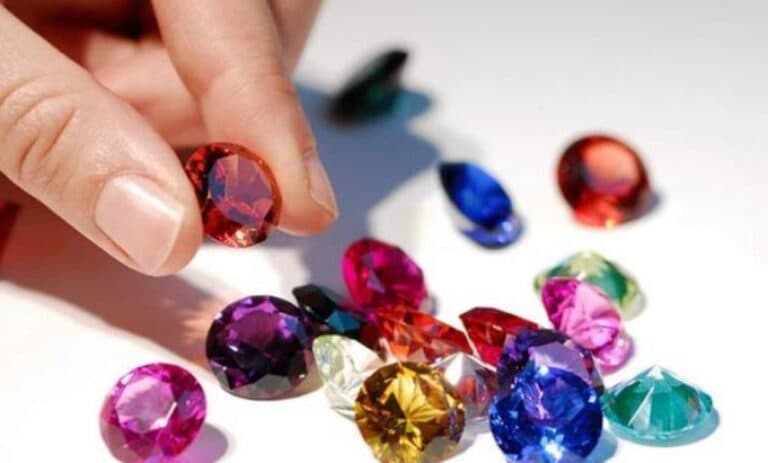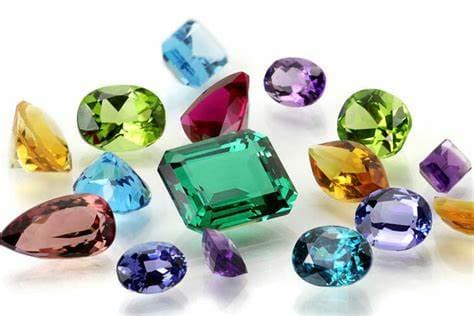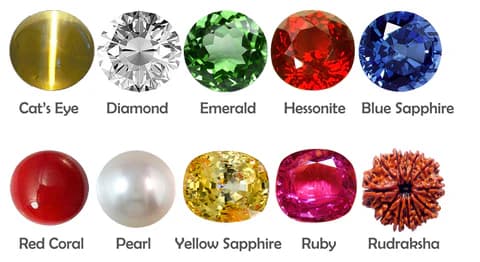Tips on buying gemstones
- Jewellery Design
Tips on buying gemstones
Contact us
Bengaluru
Campus 1 : JD School of Design, No. 18-1, Brigade Road, Bengaluru,Karnataka – 560 001.
Campus 2 : No. 40, Swan House, 4th Cross, Residency Road, Bengaluru, Karnataka – 560001.
Goa
Musthtifund Saunstha , Near Mahalaxmi Temple,Dada Vaidya Road, Goa-403001
Gemstones have captivated humanity for millennia, their beauty, rarity, and symbolism holding a powerful allure. From adorning the crowns of royalty to gracing personal jewelry collections, these natural treasures have transcended cultures and eras. Whether for personal adornment, a thoughtful investment, or a connection to a birthstone or astrological tradition, acquiring gemstones can be a rewarding experience. However, navigating the often-complex world of gems requires knowledge and informed decision-making. This article equips the burgeoning gemstone enthusiast with a practical guide, exploring key factors to consider when selecting these natural wonders.
The Four Cs: A Cornerstone for Gemstone Evaluation
The value and quality of a gemstone are primarily determined by four key characteristics, often referred to as the “Four Cs”:
- Color: This is arguably the most critical factor for most buyers. Each gemstone variety boasts a natural color spectrum, but desirability often leans towards vibrant, saturated hues with excellent uniformity. For instance, a deep red ruby with a pigeon-blood hue commands a higher price compared to a paler pink ruby. Some gemstones exhibit pleochroism, where the color appears to change depending on the viewing angle. Alexandrite, for example, displays a greenish-blue hue in daylight but transforms to a reddish-purple under incandescent light. Understanding a gemstone’s natural color range and any treatments that may have enhanced its appearance is crucial. Treatments like heat can intensify color saturation in sapphires, but the stability of such treatments should be considered.
- Cut: The cut refers to the way a gemstone has been shaped and polished to maximize its brilliance, fire, and scintillation. A well-cut gem optimizes light reflection, resulting in a dazzling play of light and color. Light entering a well-cut stone undergoes refraction, bending and separating into its component colors, which then exit the stone as a mesmerizing display of brilliance and fire. Fire refers to the flashes of color, often red, orange, and yellow, that appear within the gemstone. Scintillation is the sparkle or play of light that dances across the stone’s surface. The ideal cut varies depending on the gemstone’s inherent properties. Round cuts are popular for diamonds, maximizing brilliance due to their ability to reflect a high percentage of light. Emerald cuts, with their elongated octagonal shape and stepped facets, flatter stones with superior clarity, like emeralds, showcasing their depth of color. A poorly cut stone can appear dull and lifeless, failing to capture the inherent beauty of the gemstone.
- Clarity: This attribute assesses the presence or absence of inclusions (internal flaws) and blemishes (external imperfections) within the gemstone. Inclusions can be crystals, feathers (cracks filled with a foreign substance), or clouds (nebulous concentrations of microscopic inclusions). Blemishes can be scratches, chips, or pits on the surface of the stone. Gemstones with minimal inclusions are generally considered more valuable. However, some inclusions can be characteristic of a particular variety and may not significantly affect value. For example, “rutile silk” inclusions, which appear as fine, needle-like crystals, are often seen in sapphires and can even be considered desirable by some collectors, as they can add a silky sheen to the stone. Understanding the nature, size, and location of inclusions is crucial. Large, visible inclusions can detract from the beauty and brilliance of the stone, while microscopic inclusions may have little to no impact.
- Carat Weight: This refers to the weight of a gemstone, measured in carats (1 carat = 0.2 grams). Larger gemstones are generally rarer and more expensive, but carat weight alone is not the sole determinant of value. A smaller, high-quality stone with exceptional color, cut, and clarity may be more valuable than a larger stone with inferior characteristics. For instance, a well-cut 1-carat sapphire with a vibrant blue color and excellent clarity might be more coveted and valuable than a 2-carat sapphire with a dull color and significant inclusions.

Beyond the Four Cs: Diving Deeper for Informed Decisions
While the Four Cs provide a solid foundation for gemstone evaluation, a discerning buyer should delve deeper to make informed decisions:
- Origin: The geographical source of a gemstone can influence its value and properties. For instance, Colombian emeralds are renowned for their vibrant green color with a bluish hue, while Burmese rubies are prized for their exceptional clarity and intense red color. Understanding the origin can also provide context for ethical sourcing practices, a growing concern for many consumers. Certain regions may have a long history of mining a particular gemstone variety, and these stones may command a premium due to their established reputation. For example, Ceylon sapphires from Sri Lanka are known for their exceptional clarity and vibrant colors.
- Treatments: Many gemstones undergo treatments to enhance their color, clarity, and durability. Treatments can range from heat treatments to improve color saturation in sapphires and rubies to oiling to reduce surface fractures in emeralds. Some treatments may be permanent, while others may require maintenance or be susceptible to damage over time. It is crucial to be aware of any treatments a gemstone has undergone and their potential impact on value and stability. Reputable sellers should disclose all treatments applied to a gemstone, and buyers should inquire about the specific treatment methods used. For example, some consumers may prefer untreated gemstones, even if they have minor imperfections, while others may be more open to treated stones if the treatment is stable and significantly enhances the beauty of the gem.
- Lab-Created Gemstones: Technological advancements have led to the creation of gemstones in controlled laboratory settings. These stones possess the same chemical and physical properties as their natural counterparts but at a lower price point. Lab-created gemstones can be a viable option for those seeking a more affordable alternative or for ethically conscious consumers who may have concerns about the environmental impact of traditional mining practices. Understanding the distinction between natural and lab-created gemstones is essential for informed buying decisions. Reputable sellers will clearly disclose whether a gemstone is natural or lab-created.
- Certification: Reputable gemological laboratories, such as the Gemological Institute of America (GIA), issue certificates that document a gemstone’s characteristics, including its weight, cut, clarity, color, and any treatments it may have undergone. A certificate from a recognized lab provides independent verification of a stone’s quality and authenticity, offering valuable peace of mind. While not all gemstones require certification, it is highly recommended for higher-value stones or those with treatments that may impact value. The cost of certification can vary depending on the lab and the complexity of the analysis.
Selecting the Right Gemstone Vendor
Finding a trustworthy and reliable vendor is paramount when acquiring gemstones. Here are some key considerations:
- Reputable Gemstone Dealers: Established gemstone dealers with a proven track record and expertise are a reliable source for high-quality stones. Look for dealers who are members of professional organizations such as the American Gem Trade Association (AGTA) or the International Colored Gemstone Association (ICA). These organizations uphold ethical sourcing practices and set industry standards. Reputable dealers can offer valuable insights and guidance throughout the selection process, helping you find a gemstone that meets your specific needs and budget.
- Gemstone Shows and Events: Attending gemstone shows and events allows buyers to interact directly with vendors from various regions, compare a wider variety of stones from different origins and cuts, and potentially negotiate prices. These events offer a unique opportunity to learn about different gemstones and ask questions from knowledgeable vendors. However, conducting due diligence on vendors before purchasing is essential. Look for vendors who are affiliated with reputable organizations and have a positive reputation within the gemstone community.
- Online Retailers: The internet offers a vast marketplace for gemstones. However, exercising caution is necessary due to the potential for scams or misrepresentation. Look for online retailers with a strong reputation, transparent return policies, and detailed gemstone descriptions with high-quality photographs or videos that accurately capture the color, cut, clarity, and inclusions of the stone. Independent lab certification from a reputable gemological laboratory is a plus when buying gemstones online. Be wary of deals that seem too good to be true, and never hesitate to ask questions before making a purchase.

Beyond the Basics: Further Considerations for Discerning Buyers
In addition to the core principles outlined above, here are some additional points for discerning gemstone enthusiasts:
- Fluorescence: Some gemstones exhibit fluorescence, a phenomenon where they emit a visible light color when exposed to ultraviolet radiation (UV light). Fluorescence can be desirable in some gemstones, like diamonds, where it can enhance brilliance, but it can also be a negative factor in others, like opals, where it can give the stone an unwanted artificial glow. Understanding how fluorescence impacts a particular gemstone variety is essential for informed buying.
- Pleochroism: As mentioned earlier, some gemstones exhibit pleochroism, where the color appears to change depending on the viewing angle. This can be a desirable quality in certain stones, like sapphires that display a captivating shift from blue to green, but it can also be a factor to consider when selecting a gemstone for a specific design application. For instance, a gemstone with strong pleochroism might not be ideal for a symmetrical setting where a consistent color is desired.
- Matching and Suitability: When selecting multiple gemstones for a piece of jewelry, such as a necklace or earrings, matching the color, cut, and clarity becomes even more crucial. Striving for uniformity in these aspects creates a cohesive and aesthetically pleasing piece. Additionally, consider the suitability of the gemstone for its intended purpose. For example, a softer gemstone like turquoise might not be ideal for a ring that will experience frequent wear and tear, while a more durable stone like sapphire would be a better choice.
- Ethical Sourcing: With a growing focus on ethical consumerism, understanding the origin and sourcing practices behind gemstones is becoming increasingly important. Look for vendors who can provide documentation on the origin of their stones and adhere to ethical sourcing initiatives such as the Kimberley Process Certification Scheme for diamonds. Knowing your gemstone was sourced responsibly adds another layer of value to your acquisition.
- Care and Maintenance: Gemstones require proper care and maintenance to preserve their beauty and longevity. Understanding the specific cleaning methods and storage recommendations for your chosen gemstone is essential. For instance, some gemstones are sensitive to heat or harsh chemicals, while others may require periodic oiling to maintain their luster.

The Allure of Gemstones: A Timeless Investment
While gemstones can be a significant investment, they offer a unique combination of beauty, durability, and potential value appreciation. Unlike many other luxury goods, high-quality gemstones can hold their value or even appreciate over time, especially rare or historically significant specimens. The emotional connection one forms with a cherished gemstone adds another dimension to its worth.
Conclusion: A Journey of Discovery
Selecting a gemstone is a captivating journey that blends personal preference with informed decision-making. By understanding the Four Cs, exploring additional considerations like origin, treatments, and lab-created options, and sourcing from reputable vendors, gemstone enthusiasts can embark on this venture with confidence. Remember, gemstones are not merely beautiful objects; they can represent lasting memories, treasured heirlooms, or even symbolic connections to birthstones or astrological traditions. The knowledge gained through this exploration empowers you to make informed choices and acquire gemstones that hold not only intrinsic value but also personal significance.
